Studio Visit
Kate Pincus-Whitney Traverses L.A.’s Food Scene in Her Maximalist Paintings
The artist says the 'alchemy' of food helps us learn who we are and what stories we want to tell.
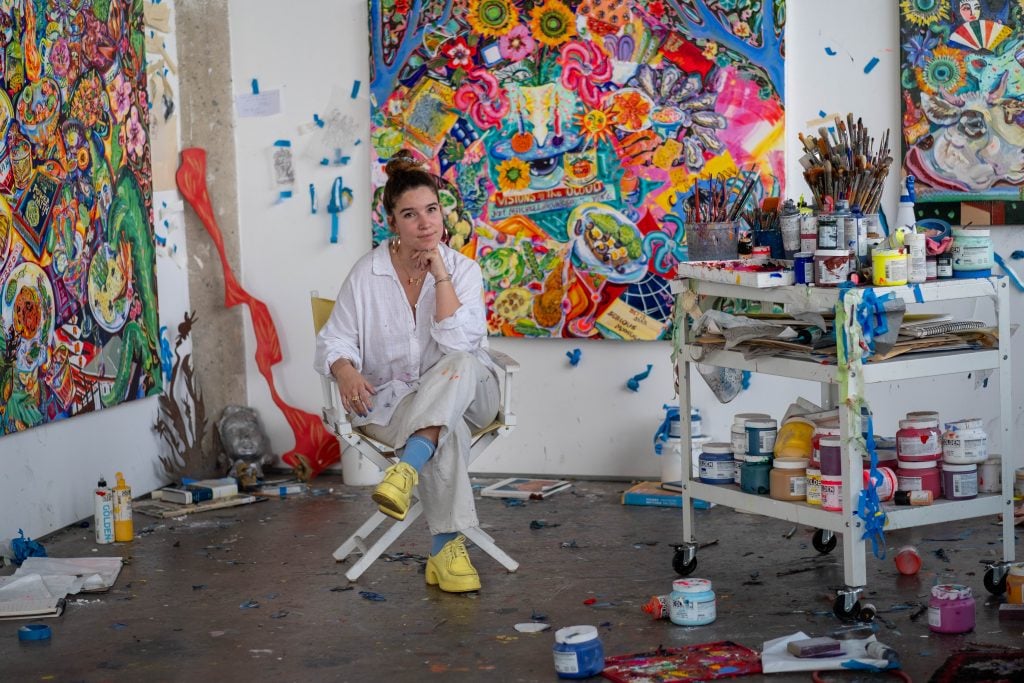
Artist Kate Pincus-Whitney has developed a large, avid following for her “maximalist”-style still lifes. On her canvases, elaborately arranged tablescapes for dinner parties and picnics await, where viewers can easily imagine (or yearn to be invited to) an impending celebratory feast, both for the eyes and the stomach.
The artist was diagnosed with dyslexia and stereo-blindness (the inability to see depth) at a young age, and quickly learned to express herself through her art. She finds inspiration in Los Angeles’s vibrant and diverse dining scene as well as in the power of food to reflect politics, culture, and identity.
Her solo show, aptly titled “To Live and Dine in LA,” opens at Anat Ebgi in Los Angeles on Saturday, June 29. It is essentially a love letter to the city and its food scene, with each painting a nod to a different neighborhood. The artist pays tribute to her childhood and the lessons learned by spending time in the kitchen with her mother and grandmother.
Artnet News caught up with Pincus-Whitney in her spacious, light-filled downtown L.A. studio on the eve of her show opening. (These answers have been edited for clarity and length)
Tell us about your studio.
My studio is in the industrial area of Downtown Los Angeles. The building is bright teal with huge windows facing the 10 Freeway. In the winter, you see a combination of palms swaying in the wind, cars lined up like little ants, and the snow-capped mountains of San Gabriel.
I share my studio with my husband Merrick Adams, with a large wall dividing our spaces down the middle. The space is long, filled with light, and music is always playing. The smells of Los Angeles Street foods come wafting in as I paint—smells of roasted green chilis, asado, and unnamable spices float together forever enticing me in the studio.
This is the largest studio I’ve ever had and it’s my absolute favorite. The ceilings are about 25 feet tall, and the sun comes blasting in from the East.
This is a big upgrade from my first studio when we moved back to LA in 2020. It had no windows and no closing doors. It’s always amazing to me how one’s space totally affects one’s work. After moving back to California from Rhode Island, all of a sudden neon colors came jumping into the work. I often also work in the backyard— certain paintings call for being outside—where I’m surrounded by eucalyptus, cactus, and sweet peas.
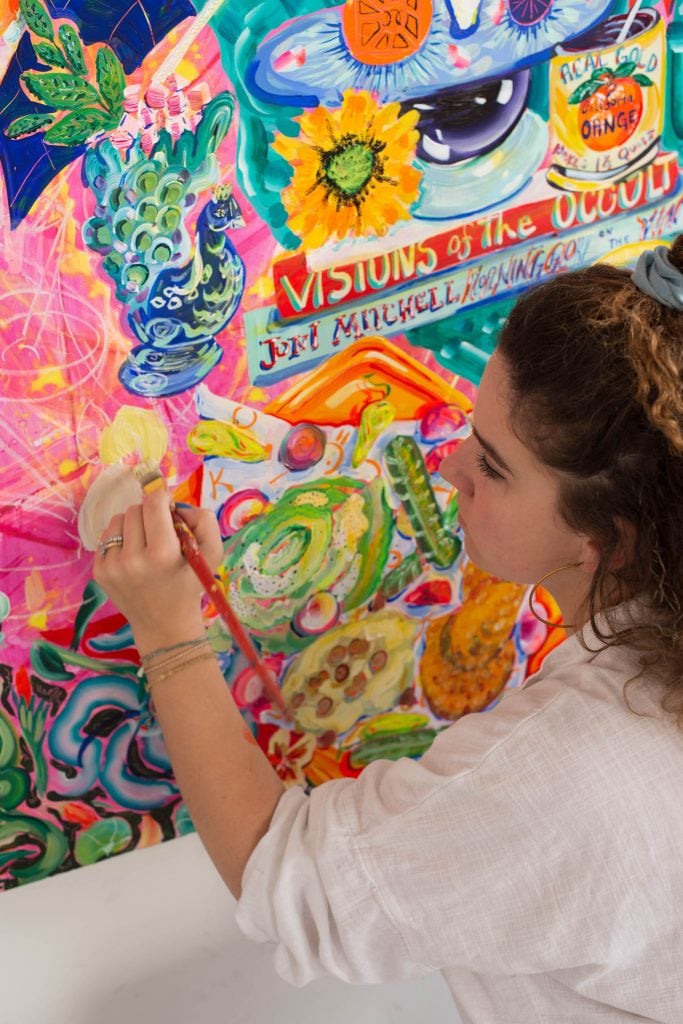
Artist Kate Pincus-Whitney at work in her LA Studio. Photo by Stephanie Macris. Image courtesy of the artist.
What are you working on right now?
“To Live And To Dine In LA / You Taste Like Home” is opening at Anat Ebgi on June 29th and will be up through mid-August. This show is an exploration of place, the idea of “home,” and art historical motifs of paradise and the sublime. Examining and exploring Los Angeles as subject/ Object/ Verb and the history of Los Angeles in relation to cuisine/ culture/ politic/ identity/ home/ magic/ and nowness.
How do we capture the essence of place, how do we make “home,” and how does food play into the psychology of our own identity and understanding of self? All the while, looking further through the ‘literal’, the ‘surface’ of the landscape and into the essences and mysteries it holds beneath. As Joan Didion put it, I am looking into the “Local Imagination” , the mythos, the shadows, and the impossible totality of how LA plays herself. And this is just the beginning.
Although set in Los Angeles, this show taps into the universal: the collective, personal, and existential of what it means to be human. Like a meal that reminds you and tastes like home, how do you capture the flavors, spices, individuals, histories, memories that all add to the taste of place? The taste of home?
I think of a city like Los Angeles as a living organism, with roads like arteries and veins that pulse into its heart, its head, and its stomach. Through the alchemy of food, we learn who we are and the stories we need to tell.
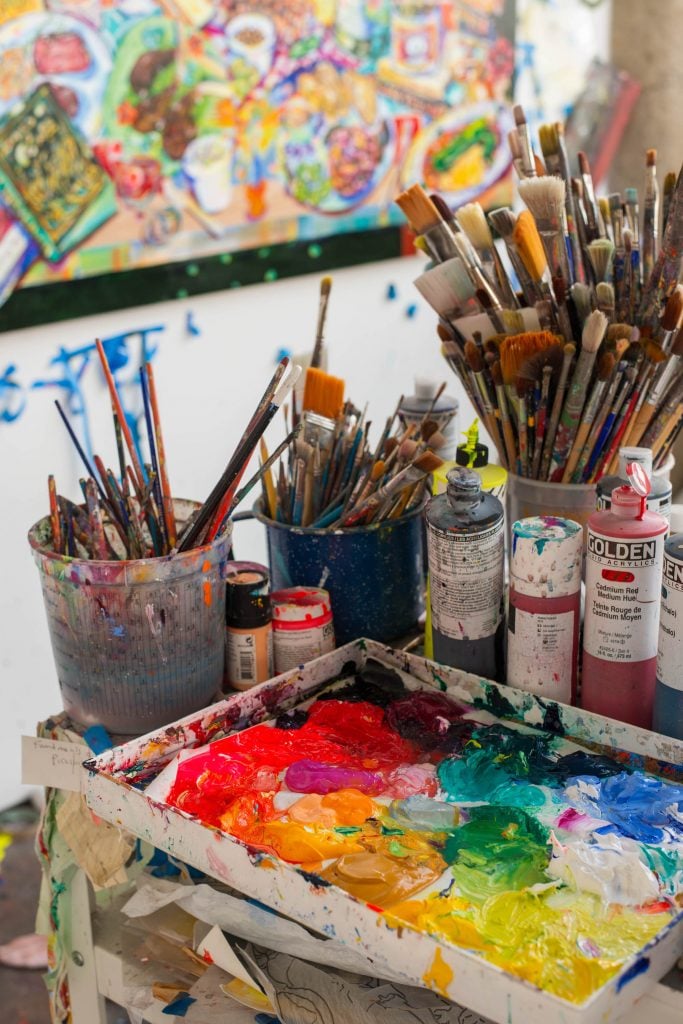
Photo by Stephanie Macris. Image courtesy the artist.
What is your working process like?
The way I begin my paintings is very physical and shamanic. I begin each work writing and divining in paint directly on the canvas in warm colors. Sometimes I glean words from my heroes like Maya Angelou, sometimes it’s automatic writings or signals. I then immediately abstract the words by wiping and actively pushing them into the canvas to become the first layer of meaning in the painting. It’s kind of an imbruing process. I then let the paintings age like cheese until I’ve forgotten what has been written underneath and I’m building the painting.
Most people don’t realize that I don’t paint anything from life. My process is heavily research based, actively archiving and grabbing images from life or online. In the piece I’m currently working on, I want to explore art historical motifs like the sublime landscape, and the bathers while still hunting to capture the essence of place and time and portrait of places.
All of the objects and foods are from contemporary life, my experience, memories of growing up in the water of the Pacific ocean, The ocean is also understood as a metaphor of the unconscious. Creating these triangulations of relationship in the painting is the core of what I am exploring through the language of paint.
All the foods are specific, and just as meaningful as David Hockney’s portrait in the corner of the PCH or Leger’s Bathers or Broad Street’s seafood tower or Dudley’s Seafood Market; all are layers of relationship that is the essence of this place—Hermeneutic Diagrams.
While I paint, I allow the painting its own collaborative voice, an open ended dialog from which I learn. I have no clue what my painting will look or become when I start and they shift shapes constantly. I think this is what gives them the magical wiggle where when you live with them they reveal themselves in time.
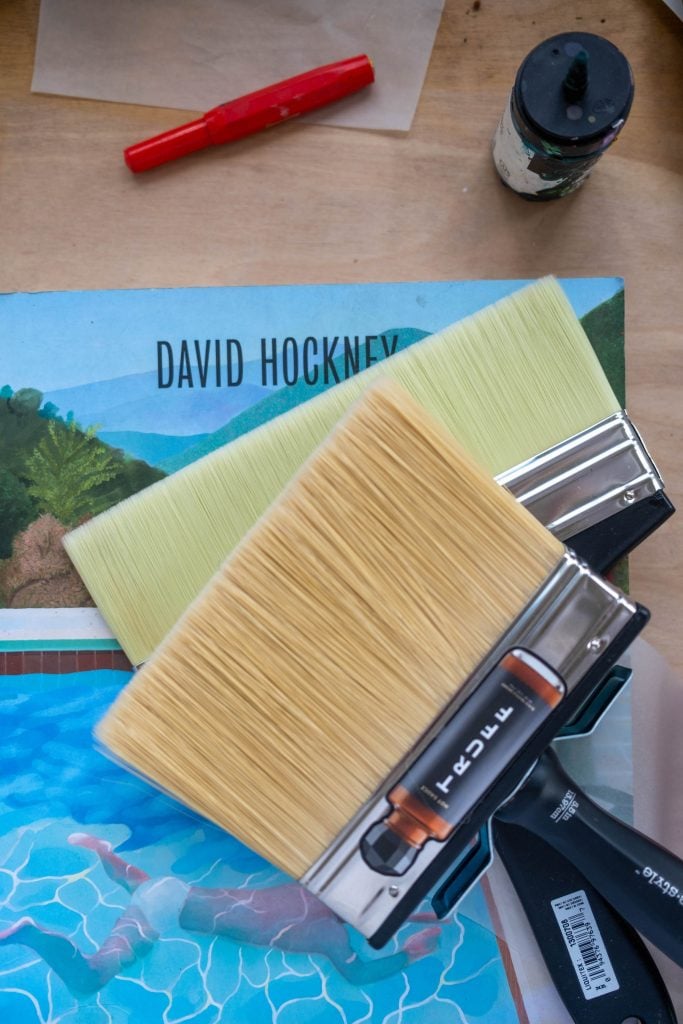
Photo by Stephanie Macris. Image courtesy the artist.
What kind of atmosphere do you prefer when you work?
I love being surrounded by music and color. I have a huge collection library of books in the studio—from Walt Whitman’s poems to Picasso’s ceramics, to books of symbols and magic, Madame Blavosky, Alan Watts, Joan Mitchell, Alice Neal, Kerry James Marshall, cook books from the Far East or ones from Kismet here in Los Angeles. I love Taschen’s books, like candies they dazzle on the studio floor. Images of vintage advertising and the Fauvists hold equal weight.
I keep my studio filled with cross-cultural sacred objects and shrines, and I’m always blasting music, from Billie Holiday to Billie Eilish, Bossa Nova, and Baloji, Lauryn Hill or Ethiopian Jazz. The music, poetry and books all flow into the work, the feeling, the rhythms of the paintings. Sometimes I like to think through reading the words of Matisse, he becomes present there in the studio with me working. I am also highly inspired by film. I love Federico Fellini (we actually named one of our cats after him… the other Pierre Bonnard). Visual storytelling in film—the use of color as emotion, of imbuing mundane objects with story and magic—that feeds my practice.
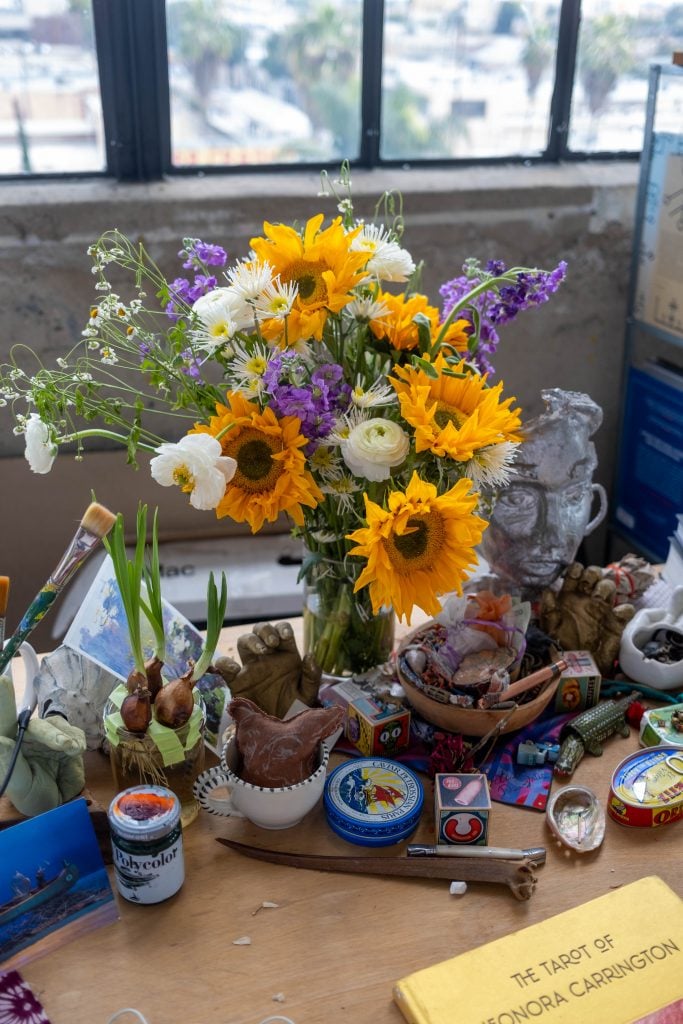
Some of the objects and books that provide inspiration for the artist. Photo by Stephanie Macris. Image courtesy of the artist.
When you feel stuck while preparing for a show, what do you do to get unstuck?
When I feel stuck it is usually that I am over-thinking, I’ve allowed ego into the studio and created invisible boundaries that I don’t allow the painting to pass. At that point (which honestly ends up with me in tears) I have to leave and spend time in nature.
But if it’s bad, then it’s to the market for salvation. I will take a two hour stroll in my local Japanese market, Mitsuwa, and then cook for hours. Inviting friends to come join is like tapping into the same way I relate to material like painting but a more direct action of love and care.

Photo by Stephanie Macris. Image courtesy the artist.
What tool or art supply do you enjoy working with the most, and why?
I love Golden Heavy Body Acrylic Paint, I also love polycolor, a paint I discovered while painting one summer in Rome during graduate school. It’s similar to Flash and is just so juicy. Also I just do a lot of carving and impasto work in my paintings. I studied neuropsychology and cultural anthropology back in the day, and playing with depth cues is one of my greatest joys where something looks flat in a picture but then you come to see it in person and it’s super-thick and luscious.
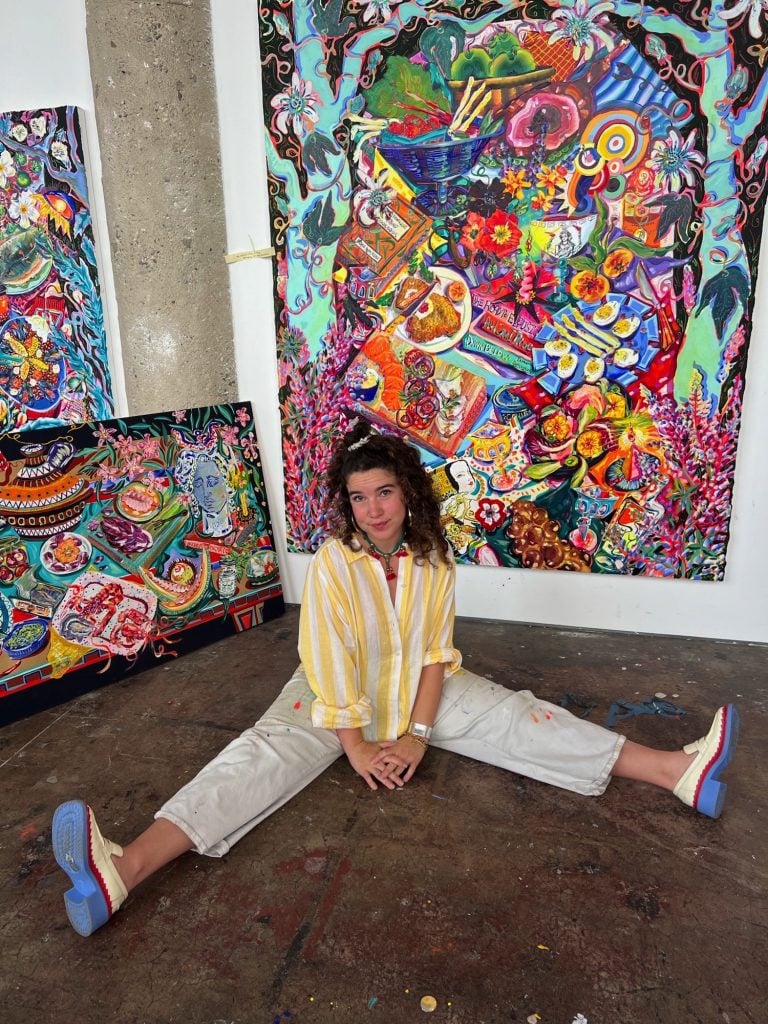
Artist Kate Pincus-Whitney in her studio. Image courtesy the artist.
How did being diagnosed with dyslexia and stereo-blindness at a young age affect your love of and approach to art?
I remember being very little when I found out I was dyslexic, I believe I was five. I still remember reading “Sam I am,” in class as the Q’s became P’s, and G’s became 9’s, the words just did not make sense. I became obsessed with having stories read aloud to me, always drawing what I heard. I became extremely fluent in synthesizing the world through visual language. It also turns out, there is a long history of artists who have been stereo-blind. I think it makes translating a three-dimensional world to a two-dimensional surface more seamless, as I already read the world on this flat plain.
I am deeply grateful for the way I see the world. Finding my own visual vocabulary and voice outside of the typical formats is exactly the reason I am doing what I am doing. I think if more people were supported and celebrated for our differences this world would be a much better place.
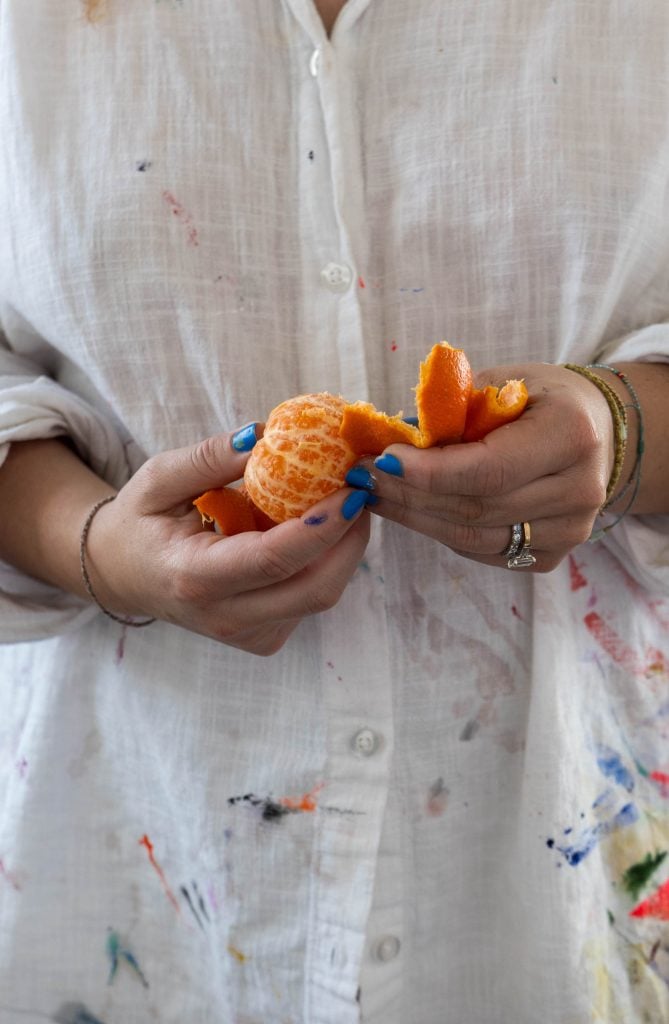
Artist Kate Pincus-Whitney takes a snack break in her LA studio. Photo by Stephanie Macris. Image courtesy of the artist.
Which LA restaurants are your favorite to dine at and why?
That feels like an impossible question to answer. Even though I have spent the past four years exploring and eating my way through this city, it is a living organism. It’s always changing, always eating itself, and creating something new.
I will say my favorite part of LA cuisine is the incredibly fresh local ingredients that are celebrated through a vast layering of cuisines—like the Iconic LA child—The Kogi Taco (Roy Choi’s love child between his Korean roots and his life growing up in Los Angeles and the amazing street tacos we are so lucky to have here).
I have packed each of my paintings for this series with all my favorite places. Lunasia for Dim Sum in the SGV, Hatchet Hall and Rutts Hawaiian on the West Side, the iconic red leather seats and dirty martinis and steaks at Musso and Frank, Mozza’s incredible Nancy’s Cesar, Kinkans thoughtful and magical ever changing tasting menu of Thai-Japanese fashion, Kismet’s impossibly good rotisserie chicken, Rosalind’s adulus special tibs and combination plates, and Broad Street’s uni, which comes from the waters I grew up in in Santa Barbara, and how can you beat a good old fashion street taco?





